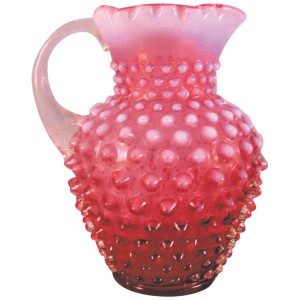This column originally appeared in August 2012.
In 1905 Frank and John Fenton opened up shop in an abandoned glass factory with the intent of hand painting glassware from other factories. Discouraged by the quality of glass available, they moved to Williamstown, West Virginia in 1907.
Led by the talents of Frank Fenton they produced glass in colors never before seen by the American public. Their earliest success came with the introduction of Carnival Glass, a glassware made by spraying a metallic salt solution over the surface of the glass immediately after it is removed from the mold. Made to mimic the expensive iridescent glass of the era from Tiffany and Steuben, Carnival was an instant success due to its affordability. Fenton made over 125 patterns of Carnival in a variety of colors, establishing them as the leading maker of this highly collectible form of glassware.
It has always been the attention to detail that draws the collector to Fenton. While they used the same molding methods as their competitors, each piece was finished with hand tools to insure superb detailing. It is this hand-finishing method that accounts for the innovative shapes found on the early Fenton pieces. You will notice as you study early 1900s glassware that Fenton becomes very easy to spot with it’s rolled edges, elongated stylings and crimped edges.
In the early 1900s Fenton was distributed by Butler Brothers wholesalers and was available at major retail chains such as Woolworth’s. It is this time frame from 1907-1913 that saw the largest growth in the long history of the company. WWI temporarily slowed production at the Fenton factory, and by the mid 1920s it was obvious that the American buying public had more practical purchases on their minds than art glass.
With their competitors failing, Frank Fenton once again brought a resurgence to production with the introduction of tableware and household items. To enhance demand, pieces of colored tableware were wholesaled to companies to be used as premiums. Plates, cups, pitchers and mixing bowls were given away at gas stations and movie theaters, and even found their way into boxes of cereal and detergent. This glassware would later become known as Depression Glass.
World War II would prove to be a time of increased sales for the company. The import of European glass ceased and Fenton picked up the slack in a growing market, developing opaque glass with Victorian characteristics.
After 104 years of quality glass production and innovation the Fenton factory closed its doors in July of 2011. Until next time . . . Linda
Linda Kennett is a professional liquidation consultant specializing in down-sizing for seniors and may be reached at 317-258-7835 or lkennett@indy.rr.com



